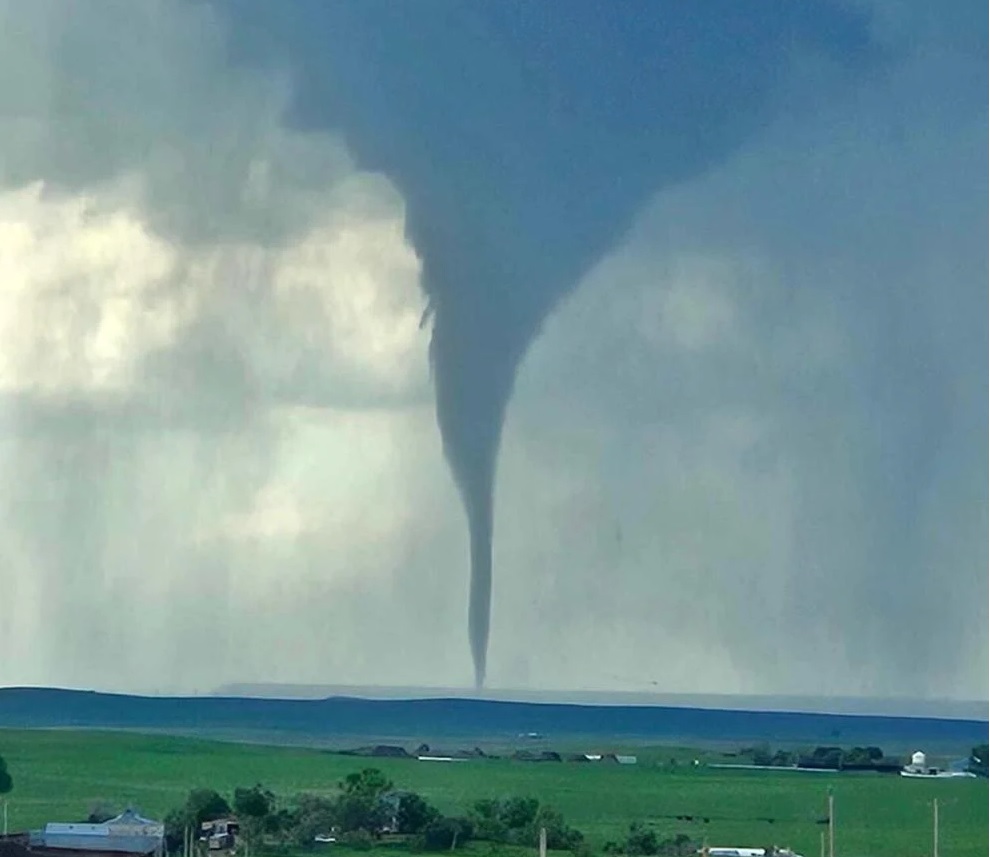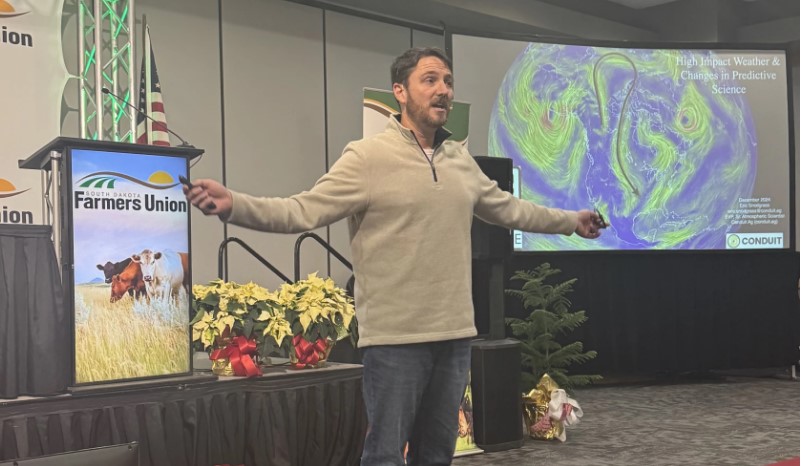HURON, S.D. – In ranch and farm country, weather gets a lot of attention. And Eric Snodgrass stands out among the climate experts farmers and ranchers follow, explained Miller, S.D., rancher Andrew Canham.
“Eric explains the weather in a way that I can understand,” Canham said.
Tabor, S.D., producers, Eileen Sestak agreed. “Eric taught us about the different facets of the weather – what impacts the weather – things you don’t hear about on the 6 o’clock news.”
Eileen and her husband, Terry say they are acutely tuned into the weather during haying season. “The heat and humidity affect haying and baling quite a bit. You have to time things just right,” Eileen said.
Canham and the Sestak’s were among a large crowd of family ranchers and farmers who heard from Snodgrass during the 109th South Dakota Farmers Union State Convention held in Huron.
Farmers and ranchers rely on atmospheric science to prepare for their next growing season.
Scientists say South Dakota’s farmers and ranchers can expect multiple storms and drought in the forecast next year.
Snodgrass is a previous professor of atmospheric sciences at the University of Illinois, Snodgrass’ talk was filled with graphs and animated meteorological data. But he also included personal stories that helped listeners wrap their heads around the data and the factors that impact weather and weather forecasting.
“The teacher who first got me interested in becoming a meteorologist told me, ‘The script of the atmosphere’s behavior is written on the ocean’s surface. Figure that out and you can figure out the future weather patterns. And that was the day became a weather nerd.’”
Based on what the ocean’s atmosphere is doing, Snodgrass predicts a dry growing season. He said it may surprise some where rain in the state originates.
“The vast majority of any precipitation that falls in South Dakota, evaporated off of the Gulf of Mexico. Your saying, ‘no, no, no, doesn’t it come from the pacific?’ No. It doesn’t comeA from the pacific. The mountains in the west, the cascades of the Sierra, the Rockies, take all of that. What you get is moisture from there,” said Snodgrass.
He said the Midwest is geographically designed to produce crops due to not having East to West running mountain chains.
Snodgrass said producers should be concerned about potential severe storms in 2025 due to the increase of weather events in 2024.
“We had 24,000 separate reports of severe weather this year. We had four million acres hit by one-inch diameter hail or larger. We had 1,700 tornados. This is the second busiest serve weather season on record,” said Snodgrass.
Snodgrass said the National Weather Service conducted a 126-year study that found Rapid City, S.D., has the least predictable weather in the United States.
He offered his prediction for how the upcoming winter season will affect the state’s crop and forage production.
“The problem is that drought never breaks in the Dakotas in winter. You know why? Your soil freezes, locks the moister in, and most of the snow that falls on top of it evaporates or sublimates and you can’t use it. That’s why I want an April 4th blizzard not a January 4th blizzard, April 4. April 4th, you get the melt water and its useful and we need it,” said Snodgrass.
Snodgrass said he’s worried about the drought going into next year.

Low Interest Physical Loss Loans Available To Producers
Ocean atmosphere indicates dry growing season
The science behind the weather is complicated. And based on what the ocean’s atmosphere is doing, Snodgrass predicts a dry growing season.
Snodgrass went on to explain: “Every single weather system that we deal with here in the Northern Plains isn’t born here. It comes from some other source region. Usually that’s either the Indian Ocean north of the Himalayan Mountains, or Siberia. That’s where your weather systems are born. They go over the Rocky Mountains and they’re invigorated. Why? The Rocky Mountains stick up there several 1000 feet into the sky and stir things up and give us fresh weather that then goes across the country, decays over the northeast, dies in the North Atlantic, and then just has a nice long funeral in a place called England. That’s why the worst weather in the world is in the UK. Then it’s reinvigorated across Asia and comes back to us.”
Snodgrass went on to say, that even though the moisture outlook is not favorable, even the best weather models in the world are only accurate 50 percent of the time.
He also shared scientifically why the Midwestern U.S. is the best place in the world to grow crops – and hail storms.
“Now, this is what’s amazing about the United States. If you want to just look geographically at a place in the world that was designed to grow crops, it is the Midwestern United States. Why? Because we have a mountain chain that runs here called the Appalachian Mountains. They’re nothing. They’re little hills. You got big ones that run over here called the Rockies. And in the middle, there is no east/west running mountain chain.”
He continued, “Do you understand that there’s only us and Argentina on the whole planet that are not impacted by east/west running mountain chains? Think about Europe, think about Russia, think about the Himalayas, China, they all have big east /west running mountains. We don’t. Which means moisture from there can go all the way to the Canadian Shield. And it’s enough. We usually get enough inches of moisture that we can do dryland farming. A lot of it comes in the middle of summer, big summer thunderstorms like this. And when that big Bermuda high is pumping all of that moisture there, it gets over the top of really hot ground and over hot ground. Guess what that air does? Shoots up in the atmosphere violently. Carries with it all that moisture, which then condenses and gives us some of the biggest and baddest thunderstorms on the planet.”
After Snodgrass’ talk, grower Terry Sestak said that although it was informative, the information Snodgrass shared does not change his 2025 growing season decisions.
“Eric admitted that even the best weather models are only correct 50 percent of the time,” Terry said. “As farmers we need to be optimistic.”
Sestak’s response is exactly what Snodgrass was hoping for. “You are not allowed to make any strategic decisions about your financial well-being,” Snodgrass said. “You bet the farm on the forecast, you’re going to lose.”












